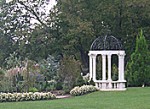 And the heat goes….and on…and no rain. We had to increase the irrigation system to include the areas where hand watering was not sufficient. Most of the perennials struggle to survive but the annuals love the heat and grow like weeds. That’s a very good thing because as the perennials fade I am planting more and more annuals to fill in the spaces. Of course, that means more attention to watering and a lot more hand watering. Showers are expected so hopefully we will get some. There is nothing like a good rain; the plants respond differently to a natural rain than to any kind of watering but I have never figured out why. Perhaps they like a cool shower without the sun beating down on them. I don’t blame them one bit!
And the heat goes….and on…and no rain. We had to increase the irrigation system to include the areas where hand watering was not sufficient. Most of the perennials struggle to survive but the annuals love the heat and grow like weeds. That’s a very good thing because as the perennials fade I am planting more and more annuals to fill in the spaces. Of course, that means more attention to watering and a lot more hand watering. Showers are expected so hopefully we will get some. There is nothing like a good rain; the plants respond differently to a natural rain than to any kind of watering but I have never figured out why. Perhaps they like a cool shower without the sun beating down on them. I don’t blame them one bit!
I can complain about the lack of rain but not about the irrigation system. I guess we have been over zealous because I found this guy in the back lawn.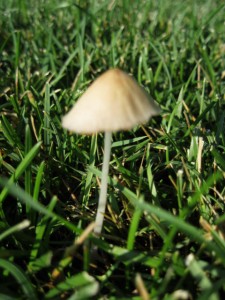
You never know what your neighbor’s irrigation system will do for you. We recently had a couple of arborvitae on our property line die recently for no apparent reason.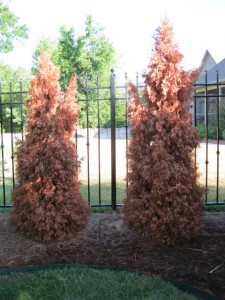
A few yards down from the arborvitae some dune grass we planted on a slope with terrible soil started growing well and looking good so we watched; the neighbor’s irrigation system spills over a little onto our property and it seems to be just enough to kill our arborvitae but make our dune grass flourish.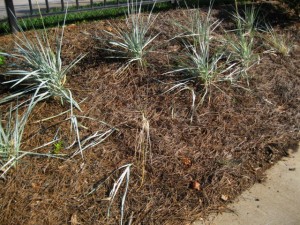
While cleaning up the daylily debris in the allee I noticed that the crapemyrtles there are exfoliating. I have always enjoyed the pretty patterns on the trunk and branches of these trees but never seen them in the process of exfoliating.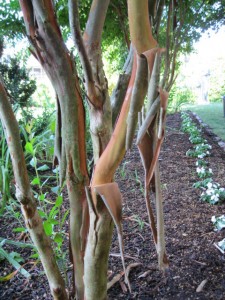
The grasses are beginning to come into their own. The dwarf fountain grass Pennisetum “Hameln’ is pushing up its fuzzy looking flowering stalks.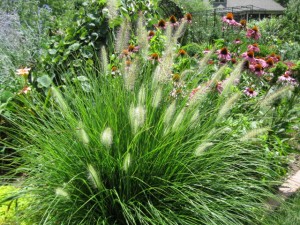
Northern seas oats, Chasmanthium latifolium, profited from the early spring rains and is larger than ever before. I have had to ripe out handfuls of it and wish it were in the middle of the border it is so large this year. For the first time I have hung a handful of stems to dry them for fall use in dried arrangements.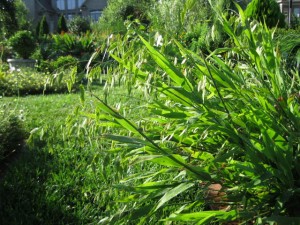
The stars of the formal garden are the true lilies. The stargazer lilies (blooming with a single volunteer of cleome) are still going strong and continue to scent most of the garden with their heady fragrance.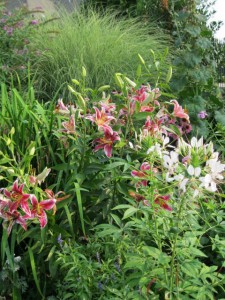
The oriental hybrid lilies are well over 6’ tall and are covered with buds as well as a few flowers. They have huge strong looking stems but the plants are so top heavy they lean like the tower of Pisa. Next year I will make sure they have some support.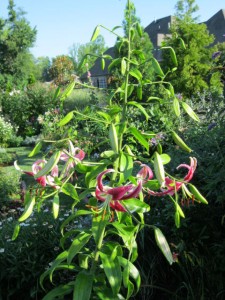
The flowers are quite unusual looking. They hang in a way that reminds me of the roof of a Chinese pagoda; the outside of the petals is white, the inside deep red. It is a beauty and fragrant too!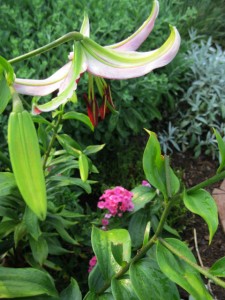
The daylilies in the formal garden are later than those in the allee, which are all finished. The formal garden is a little lower than the allee and perhaps cold air drainage causes the different bloom times for some of the daylilies. The old favorite ‘Hyperion’ can be counted on for a very long bloom growing here with variegated miscanthus grass; nice echo of yellow in the grass stems.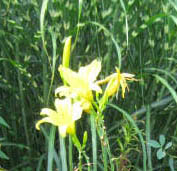
This unnamed daylily makes a nice companion for red barberry.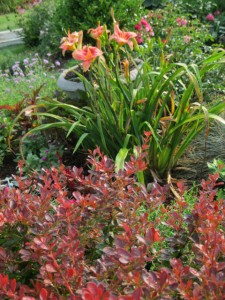
The orange and red tones of ‘Fire King’ are looking nice with the last blooms of butterfly weed.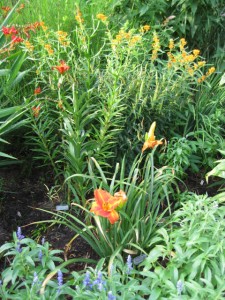
And this golden arborvitae really sets of the lemon yellow of the daylily I brought from my previous garden.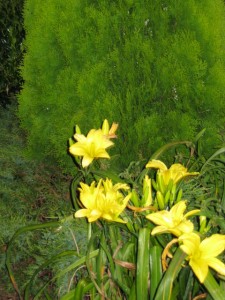
Elsewhere in the formal garden the liatris finds a good companion with the pink phlox.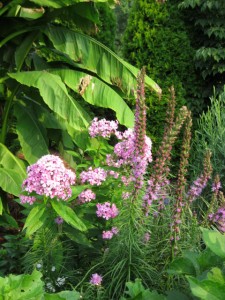
The hollyhock that I had to cut back last week has responded with more flowers and bigger ones on the one stalk that I left. I feel like Jack with this hollyhock instead of a beanstalk.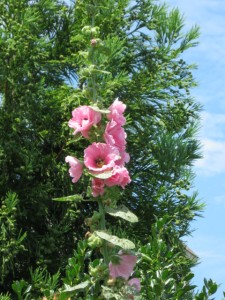
A single dill flower has come into bloom on new growth after I cut the dill back severely.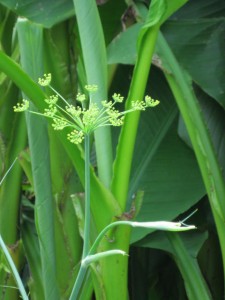
One of the dianthus plants has bloomed; I love the mini carnation-like flowers but find the blue green foliage a big asset all season long.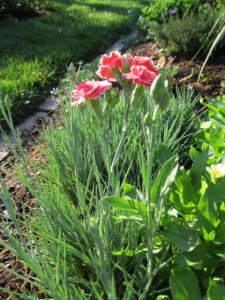
All over the formal garden the butterflies come to rest. Most of them are yellow swallowtails.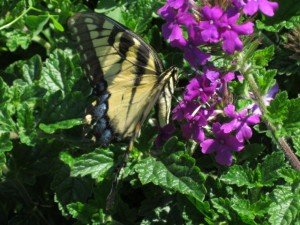
We have an occasional black one visit too.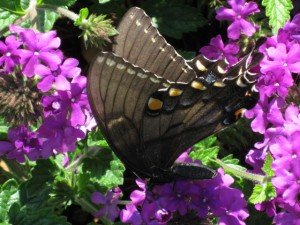
Two roses are making a grand show in the rose garden. The flowers of ‘The Alexander Rose’ remind me of dogwoods. Most David Austen roses are large and full, looking like old garden roses, but have a tendency to develop black spot. This one is very different on all counts.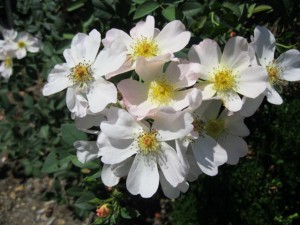
The floribunda rose ‘Evelyn Fision’ is producing a profusion of blooms in a gorgeous color of red.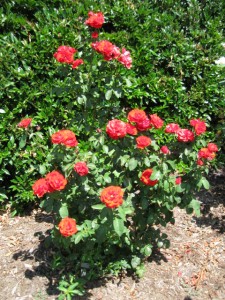
My new acquisition, the floribunda ‘Easy Does It’, is blooming for the first time in situ.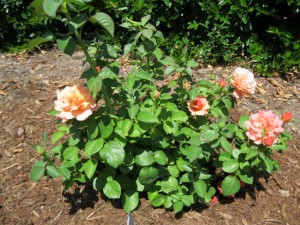
The blend of colors in the flowers as they open are what grabbed me.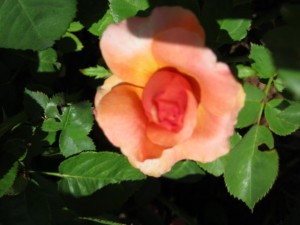
In addition to summer squash and cucumbers, we harvested some acorn squash.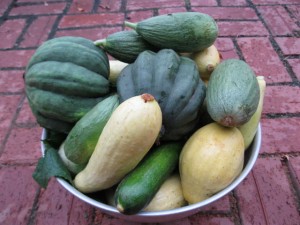
We enjoyed the acorn squash by grilling them with just a brushing of oil, adding a honey glaze after turning them.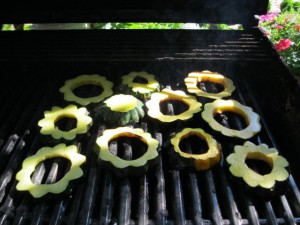
The eggplant are getting long and should be ready soonmanthium.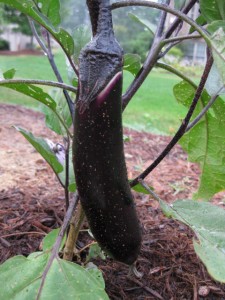
Italian dinners are coming up!
